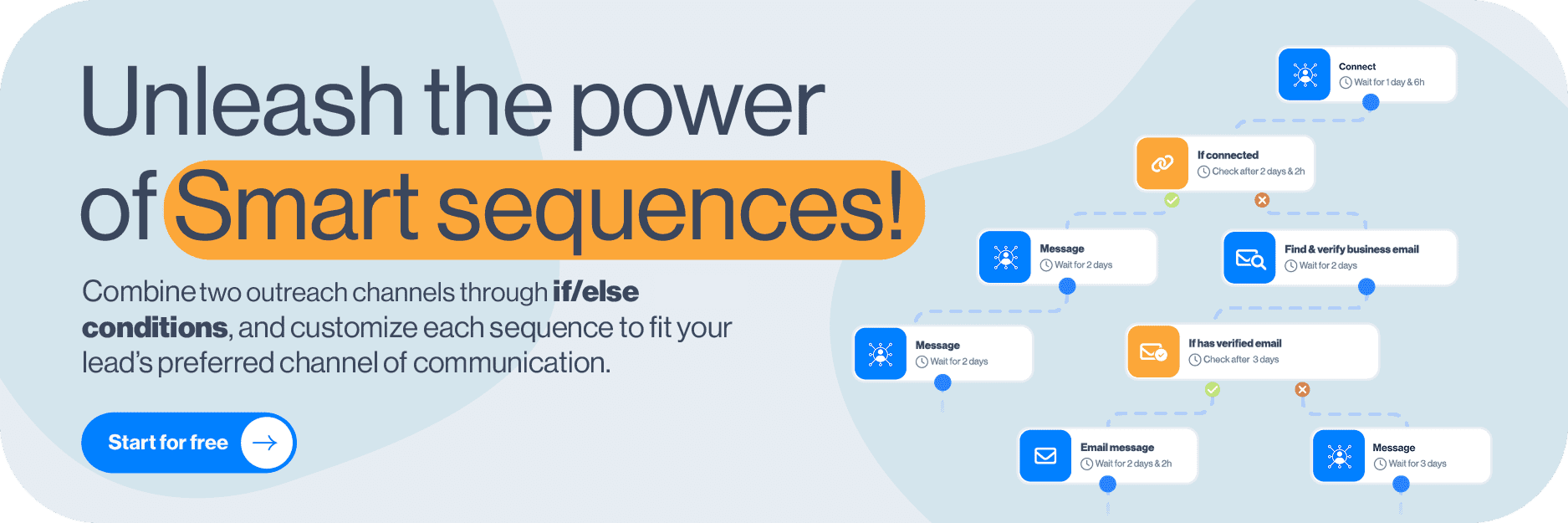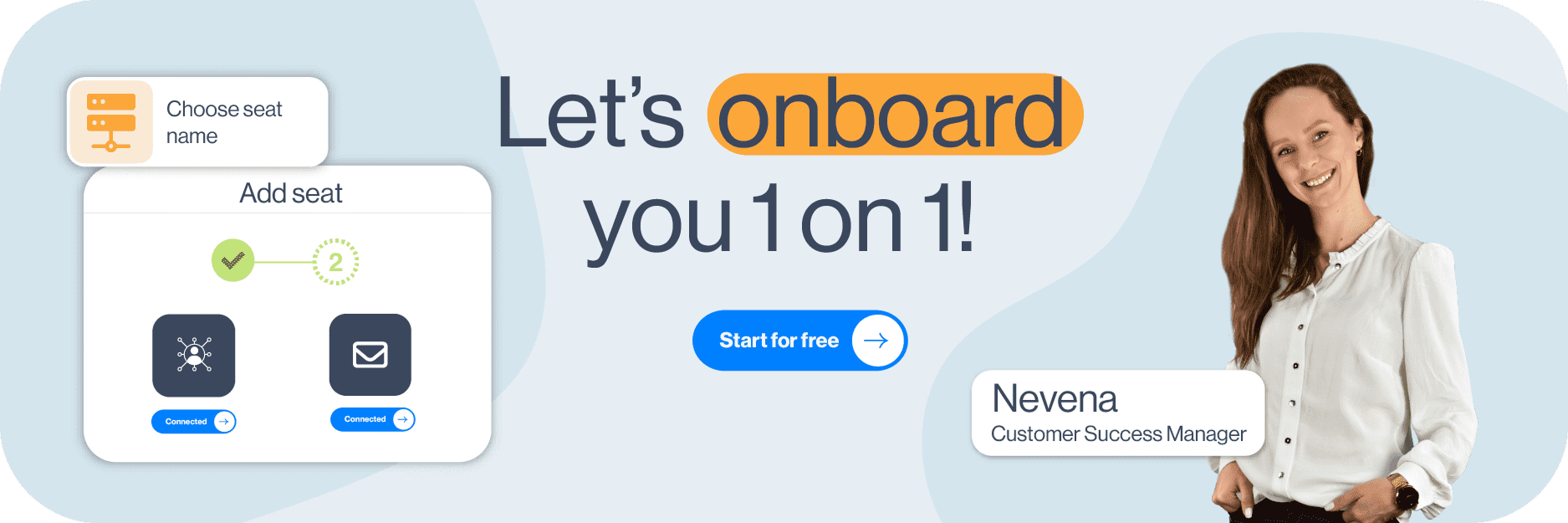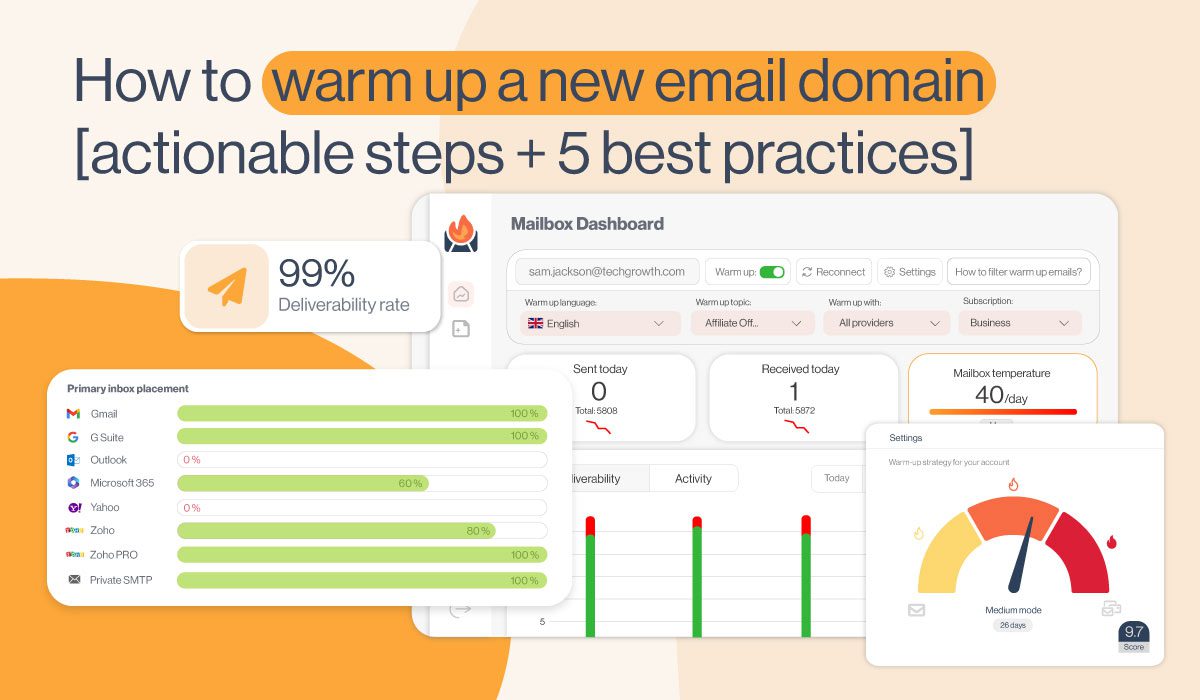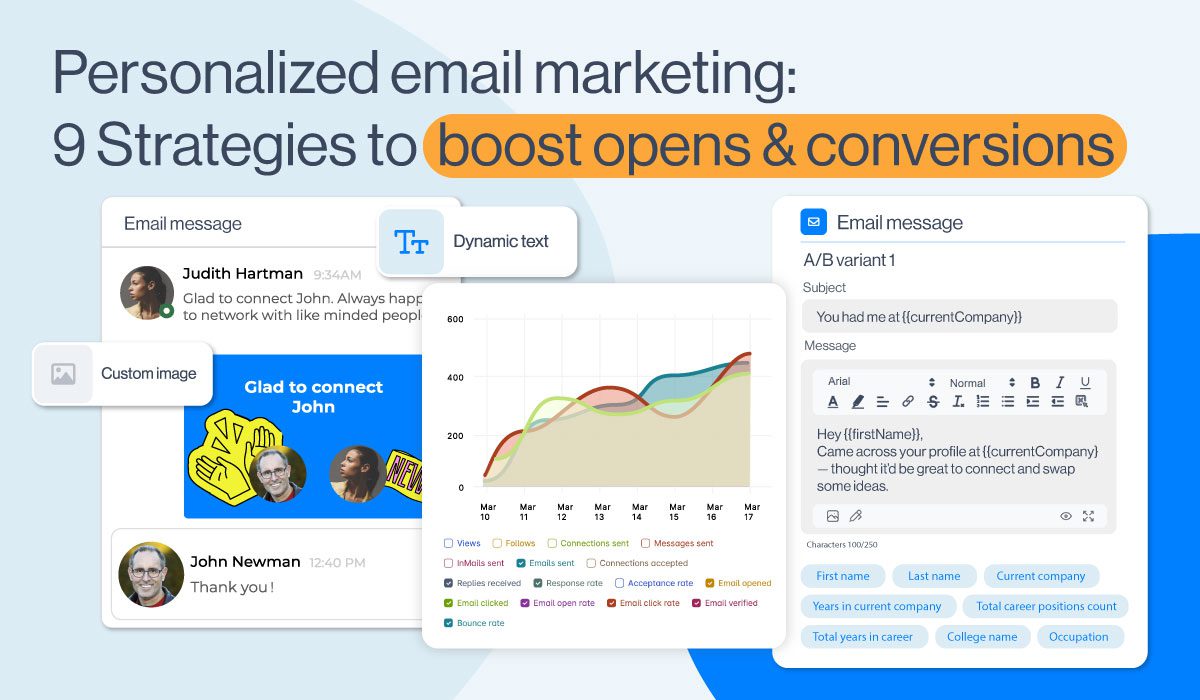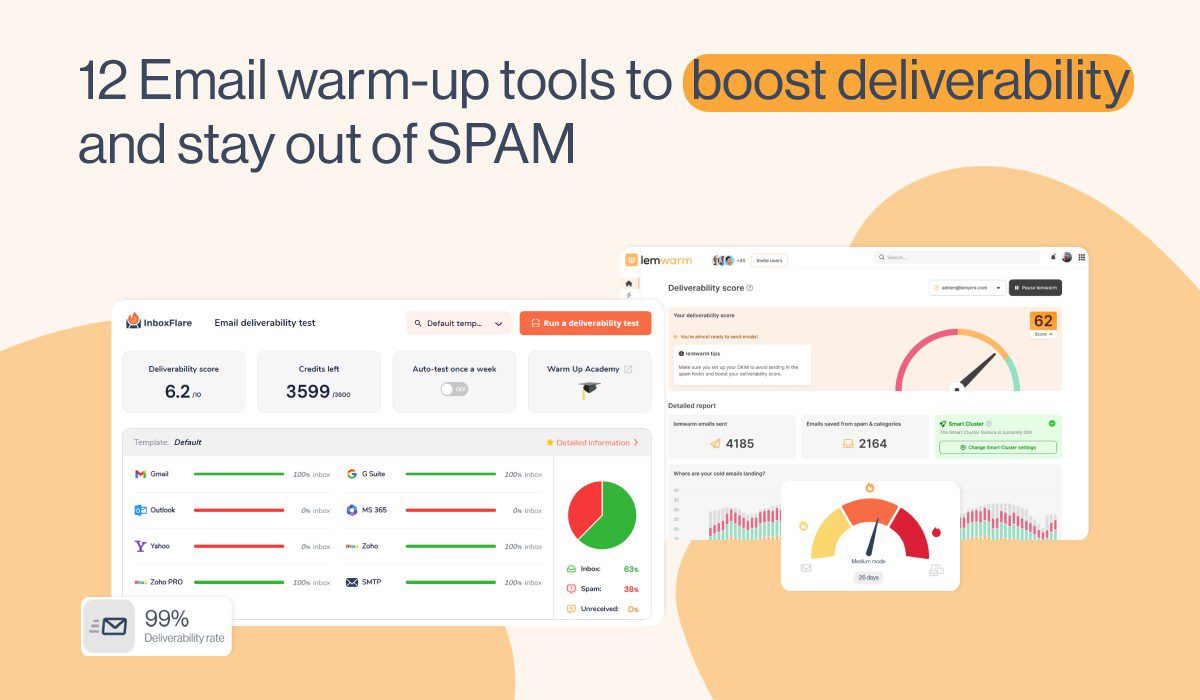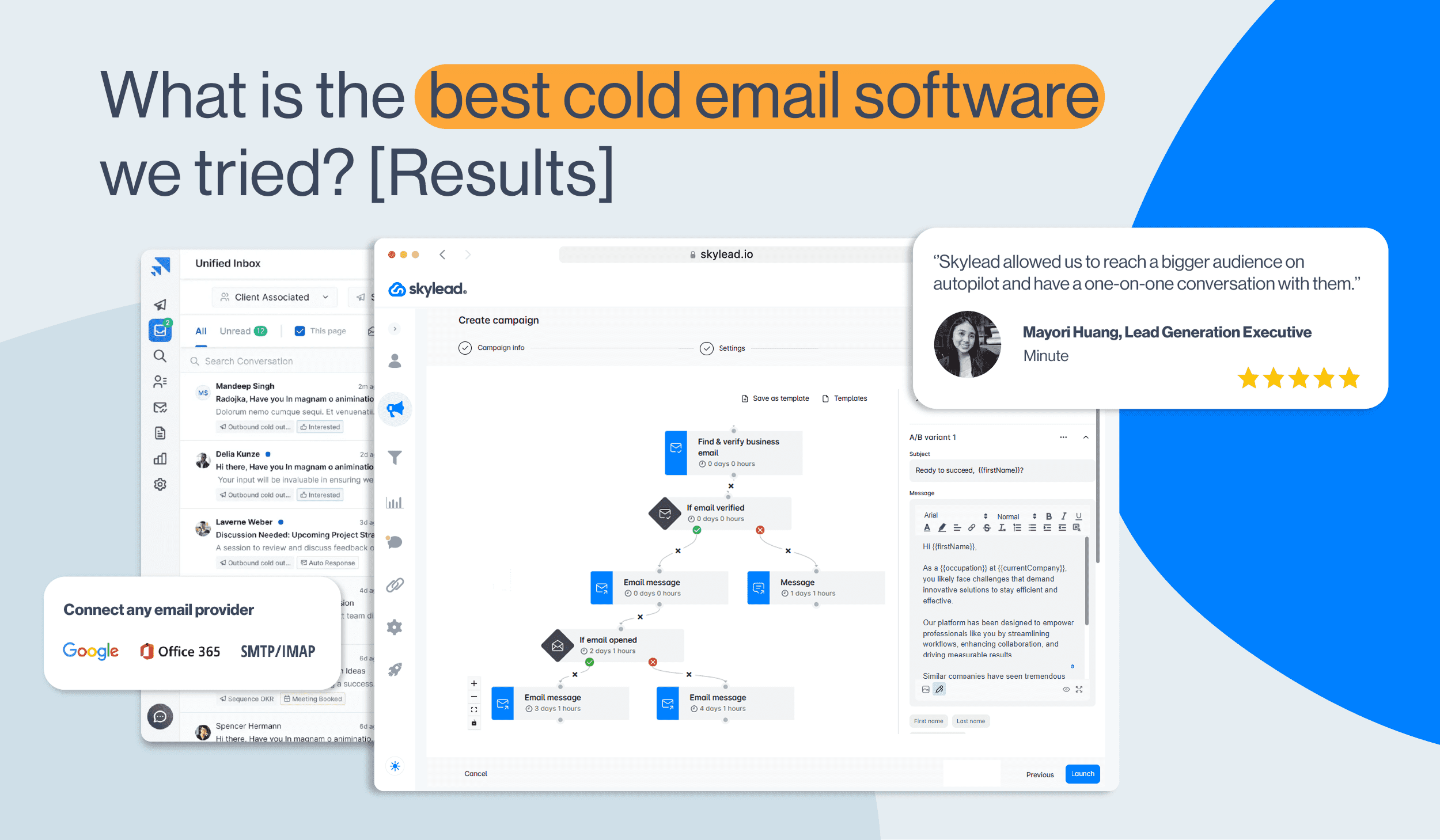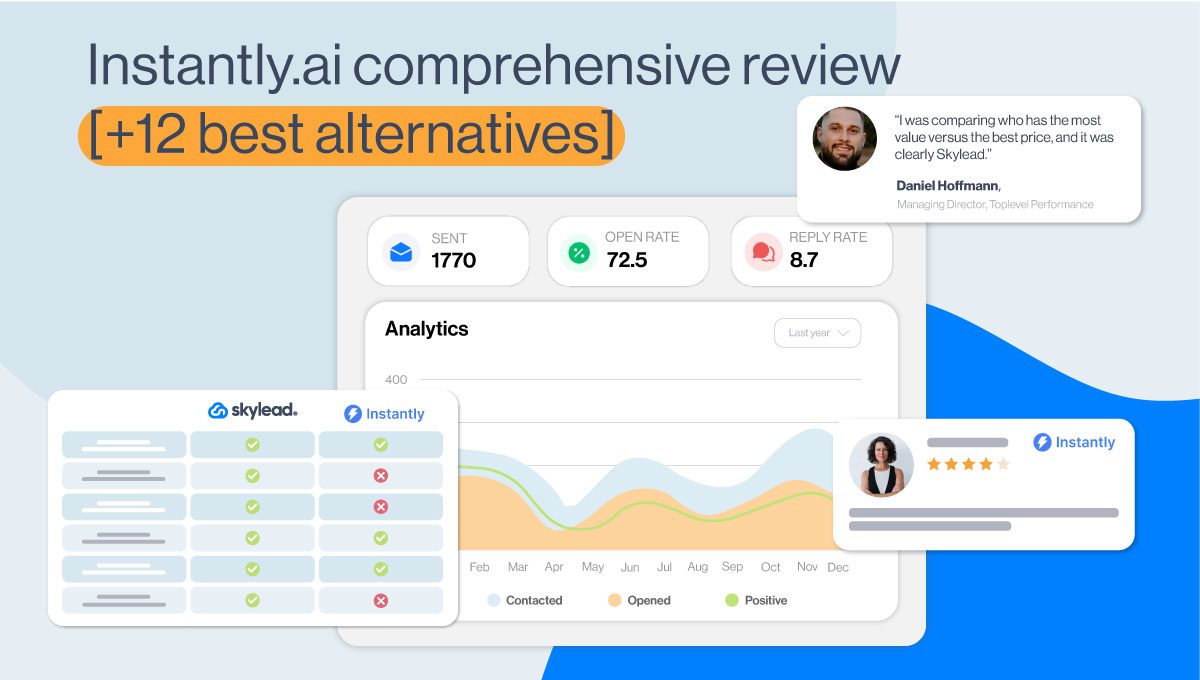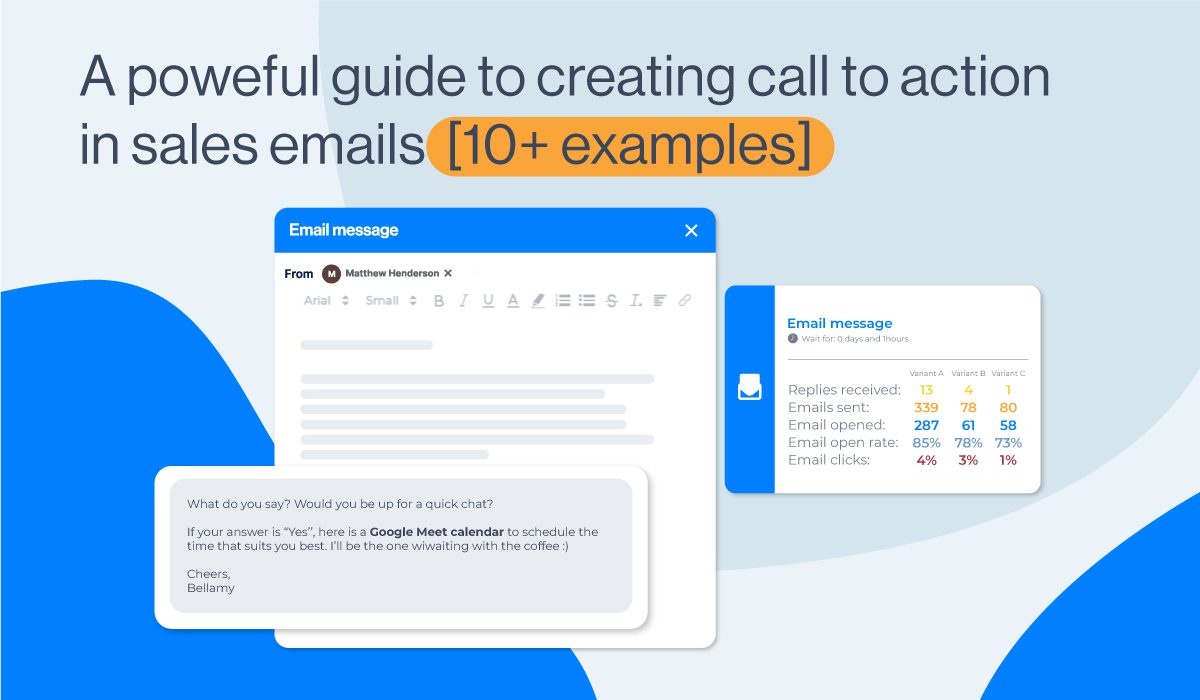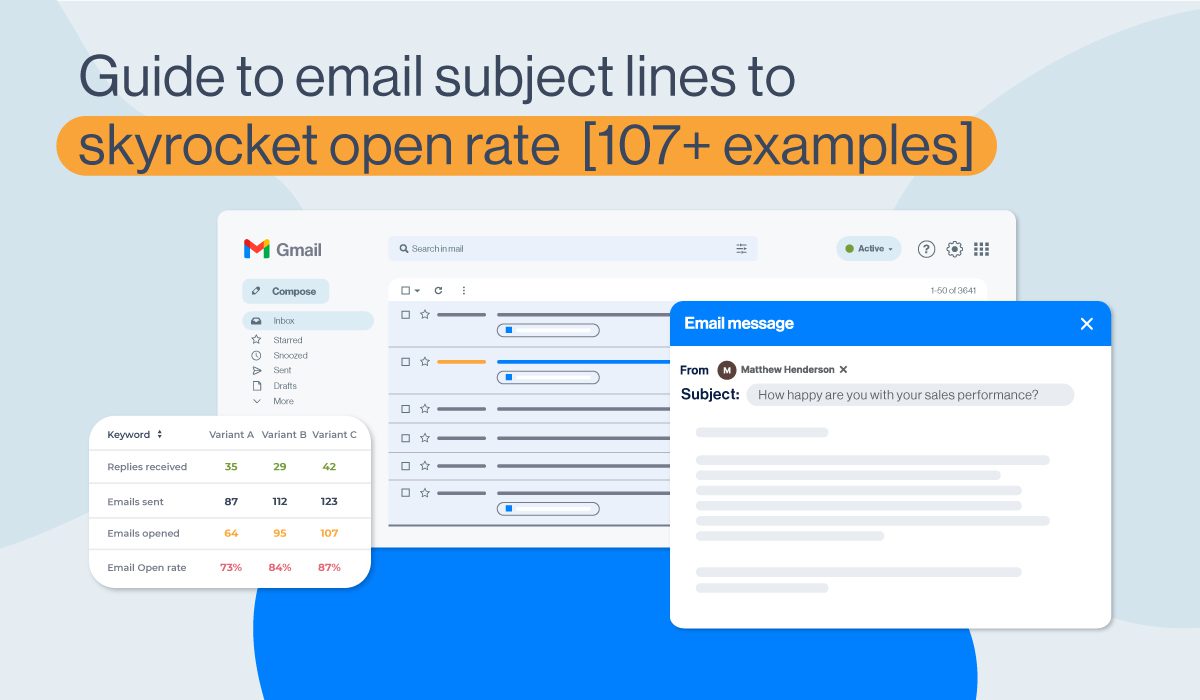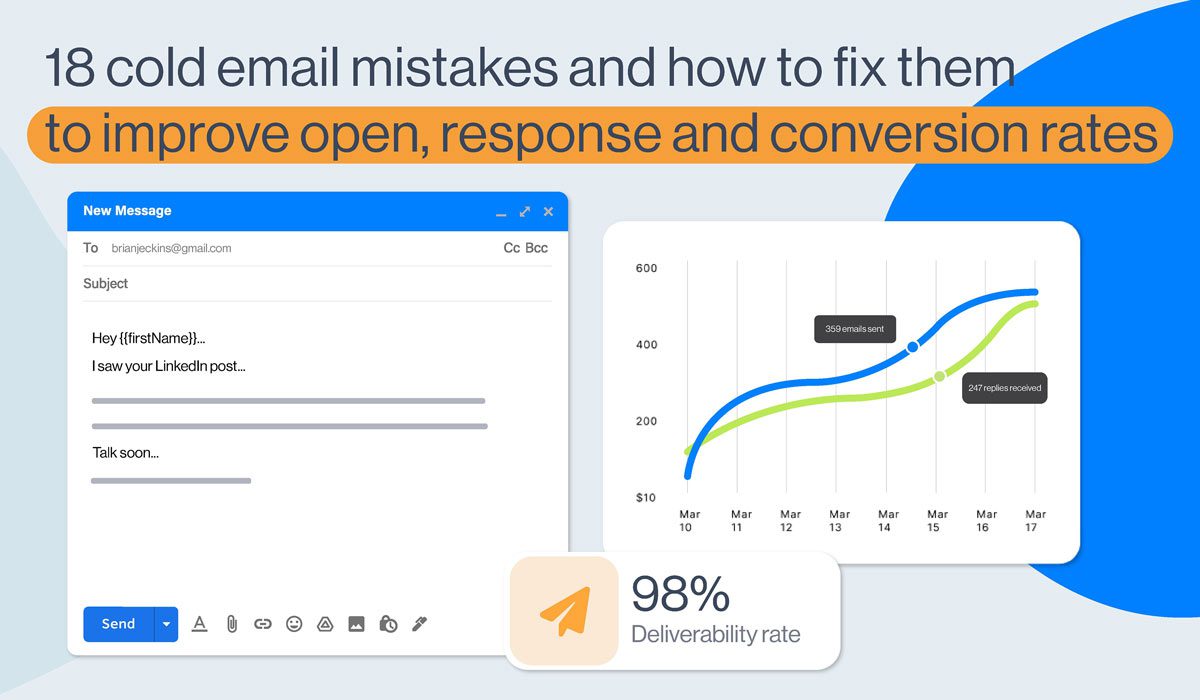The ultimate email outreach strategy: How to plan, personalize, and scale successful campaigns
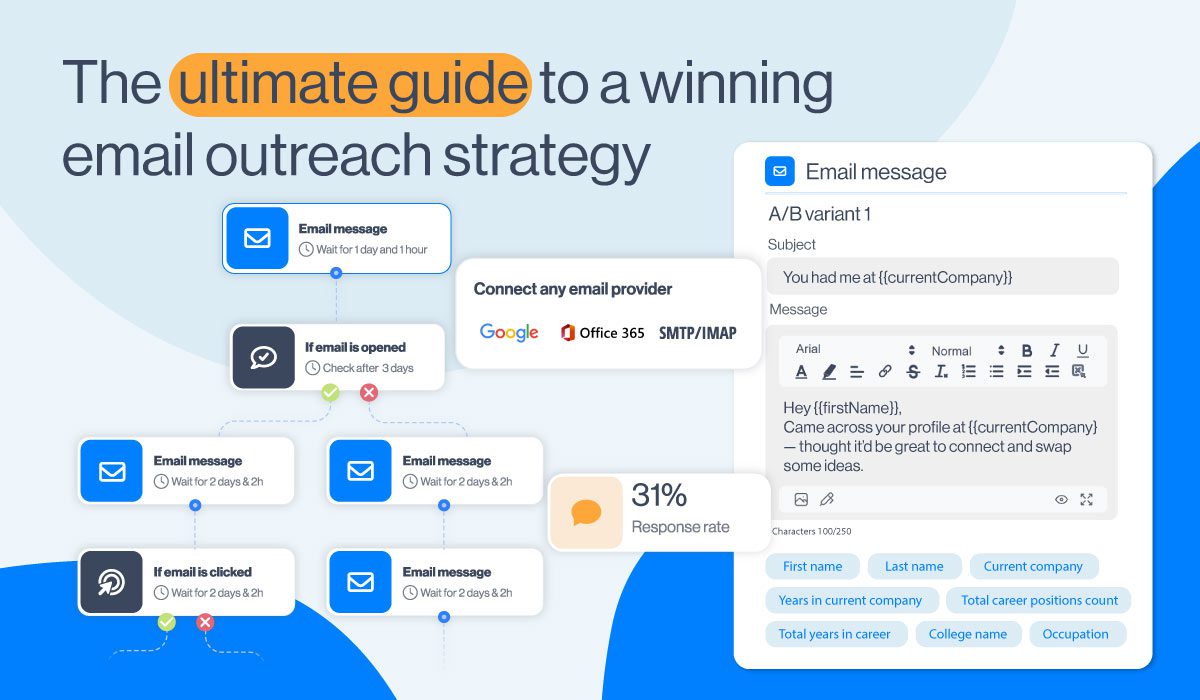
Nowadays, email outreach is the center of modern growth. Whether you’re running outbound sales, building marketing partnerships, or earning backlinks, your email outreach strategy shapes how you start conversations, qualify interest, and build long-term customer relationships. When done well, it becomes one of the most well-oiled engines for lead generation and scalable outreach.
From our experience working with thousands of sequences, we’ve seen that most outreach fails for predictable reasons:
- Inboxes are overcrowded,
- Personalization feels robotic
- Deliverability rules keep tightening.
That means success in cold outreach isn’t just about writing a good email - it’s also about designing a system that gets seen, feels relevant, and builds trust fast.
This guide shows you how to design that kind of system - a strategic, high-leverage approach to outbound sales that helps you cut through the noise, scale without losing quality, and turn every email into an opportunity. We’ll go through:
- What makes a good email outreach strategy
- The right channels for email outreach
- Key components of high-performing email strategies
- A step-by-step guide for building a solid email strategy
- Best practices and how to measure the success of your campaigns
As you can see, there’s a lot we cover, so grab a cup and let’s begin.
What makes a successful email outreach strategy
A successful email outreach strategy is built on four key things:
- Tight targeting
- Clear value
- Personalization
- Consistent follow-ups
The best email outreach campaigns focus on smaller, high-quality lists, messaging that solves a specific problem, and simple CTAs that make replying easy-peasy. From our experience, relevance drives results, whether you’re running cold outreach, inbound sales, outbound sales, or link-building workflows. Let’s break down some basics.
What is email outreach and how it works
Email outreach is the process of contacting someone with a clear purpose, like booking meetings, securing partnerships, earning backlinks, or nurturing leads. A strong email outreach campaign follows this proven workflow:
find qualified prospects → write messages that deliver value from initial message to breakup email → create and start your campaign → measure responses → refine
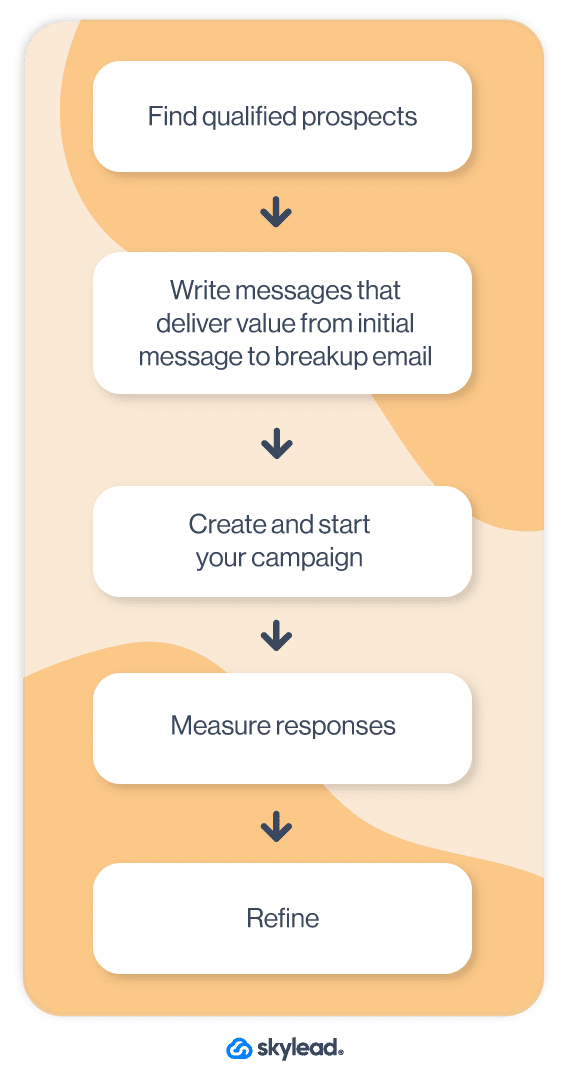
If you want faster wins, focus on these three things:
- The opener: Make the first line specific to them, not your offer.
- The value line: Show what they gain in 5–8 words.
- The follow-up: Send 3–5 follow-ups. The majority of replies come after email number 3.
This structure works across inbound sales, outbound sales, and link building.
Email outreach vs cold email outreach
Email outreach includes any strategic message: warm, cold, or follow-up. Cold outreach is only the first-touch message sent to someone who doesn’t know you. Cold emails need sharper personalization and a tighter CTA because you haven’t earned attention yet. Warm emails can rely on existing interest, past interactions, or mutual context.
Inbound vs outbound approaches
Inbound outreach starts when someone raises their hand. That means a signup, a reply, a demo request. In inbound sales, speed matters - fast responses convert up to 3x better.
Outbound outreach starts with contacting the lead first. In outbound sales, accuracy is key. The tighter your targeting, the higher the reply rate. Outbound wins when your list is high-quality, your offer is specific, and your first line proves you did at least 30 seconds of research.
Main goals of an email outreach campaign
Every strong email outreach campaign ties back to four practical goals your team can measure:
1. Lead generation - Your pipeline creation mechanism. Expect the highest conversion when your ideal customer persona is narrow and your message and offer are razor-sharp.
💡 Quick tip: Add a soft CTA (“Worth exploring?”). It can boost lead generation replies.
2. Link building - Outreach for SEO growth. Successful link-building emails offer value upfront, not just a request.
💡 Quick tip: Include a micro-incentive (a quote, statistic, or resource they can use).
3. Relationship nurturing - Stay top-of-mind with warm leads, partners, and past customers. Nurture campaigns support both inbound sales and outbound sales without sounding salesy.
💡 Quick tip: Send 1 value-only touch each month (no pitch).
4. Sales conversions - Move the conversation forward with short, specific asks.
💡 Quick tip: Add one curiosity-based follow-up. It often lands the meeting.
Choose the right channels to support your email outreach strategy
Your email outreach performs better when it lives inside a larger communication system. The strongest teams build a multichannel workflow where each communication channel reinforces the other, warming prospects before the first touch and keeping momentum alive afterward.
Multichannel outreach
Email becomes significantly more effective when you pair it with LinkedIn outreach, thoughtful touches on social media channels, and even well-timed phone calls. From our experience, adding a second channel can increase reply rates by 30–50% because prospects recognize your name before you hit their inbox.
Quick moves that work:
- View their profile before emailing → boosts recognition.
- Send a LinkedIn follow request → then email the next day.
- Call after the third email → creates urgency and builds trust.
Match channels to audience behavior
The right channel depends on how your audience prefers to communicate. Executives respond well to short emails and direct phone calls. Creators and marketers often react faster on social media channels. Technical buyers appreciate clarity-first emails and value-driven resources.
Don’t forget to use lead magnets and buying signals (new funding, hiring spikes, product launches, job changes) to warm contacts before outreach. A prospect who downloaded a guide, attended a webinar, or commented on a post is far more likely to respond because they’ve already engaged with your brand.
💡 Quick rule to live by: Warm them on one channel → convert them on another
Key components of a high-performing email outreach strategy
A strong email outreach strategy isn’t built on volume; it’s built on structure. When your technical setup, research, messaging, and timing work together, inbox placement improves, replies increase, and your entire pipeline becomes easier to scale.
Many teams streamline this process by centralizing their outreach workflows inside sales engagement platforms like Skylead, a multichannel sales engagement tool, which helps them stay organized, track performance, and keep every step of the strategy aligned. Let’s take a look at some key components to watch out for:
- Email infrastructure and deliverability
- Lead acquisition and prospect research
- Personalization and non-salesy messaging
- Strong follow-ups
1. Email infrastructure and deliverability
Your outreach results depend on whether your emails actually reach the inbox. Set up your sender domain early, authenticate it (SPF, DKIM, DMARC), and monitor delivery rates weekly. We recommend building a clean domain reputation and warm up your email domain gradually. Remember: keep your bounce rates below 3% and you’ll be good to go.
Also, avoid classic spam triggers: misleading subject lines, heavy images, long footers, blacklist words, and rapid sending spikes. Stay compliant with GDPR, CAN-SPAM, and local regulations. Compliance protects your domain as much as it protects your prospects.
🔥 Hot tips:
- Keep email text simple and human.
- Limit links to one per email.
- Remove inactive contacts monthly.
2. Lead acquisition and prospect research
High-quality outreach starts with good lead acquisition. Strong prospect research gives you the “hook” that personalization is built on, like industry pain points, job changes, or company growth.
Data accuracy matters the most. Poor segmentation destroys even the best messages you come up with. To avoid this scenario, run regular data cleanup, refine your ICP, and group leads by intent or lifecycle stage. The cleaner your list, the stronger your reply rate will be.
🔥 Hot tips:
- Add a “reason for reaching out” column in your lead sheet.
- Segment by role + industry for more relevant messaging.
- Remove anyone who hasn’t engaged in 90 days.
3. Personalization and non-salesy messaging
Personalization works when it feels human, not robotic. For personalized outreach, use specific personalization elements, like a recent post, company milestone, or shared connection, to show you did your homework. Avoid pushy pitches. Write in non-salesy language that aligns with your buyer’s tone and industry.
From our experience, shorter emails with a clear angle outperform long explanations. Your goal is to start a conversation, not close the deal in one message.
🔥 Hot tips:
- Personalize the first sentence only.
- Mirror the prospect’s tone (formal, casual, technical, concise).
- Use one simple CTA: “Worth exploring?”
4. Strong follow-ups
Most replies happen after the first touch, which is why strong follow-up emails are non-negotiable, especially follow-up emails after no response. For most teams, 4–6 follow-ups work best, spread out over several days depending on your outreach timing and sales cycle length. Our Head of Sales, Andrea, says to avoid “just bumping this up” messages. Instead, offer new value each time.
Use drip campaigns that blend soft nudges, new angles, case studies, or one-line check-ins. Just keep in mind that a well-timed follow-up can double your overall reply rate.
🔥 Hot tips:
- Use no more than 20–40 words per follow-up.
- Switch angles: new benefit, new pain point, or new question.
- End the sequence with a break-up email that invites future contact.
Personalization techniques to boost your email outreach response rates
Personalization isn’t just message decoration. It’s the engine behind high reply rates. When your message feels written for one person, your entire personalized outreach messaging strategy becomes more effective, more human, and more scalable. So let’s see what you should include in your messages.
Personalized subject lines and openers
Your email subject line decides whether your message gets opened, so make it personal and specific. Use variables like first name, company, or role naturally instead of stuffing them in awkwardly. From what we’ve seen in outreach, the first line matters just as much: it sets the tone, signals relevance, and proves the email isn’t mass-sent.
Ideas to try:
- Test 3–5 variations per sequence to see what earns the highest open rates.
- Start with context: a recent event, job change, product update, or shared connection. (“Congrats on your promotion! What are the new responsibilities you are facing now?”)
- Keep the opener under 12 words for maximum impact.
Interactive and visual personalization
Adding visuals creates a moment of surprise, and that moment increases response rates. Use personalized videos or short interactive content to make your outreach feel high-touch without slowing down your workflow. This works especially well for demos, product intros, and lead nurturing campaigns where prospects need to see value, not just read about it.
Ideas to try:
- Record a 15–30 second video explaining the “why” behind your outreach. Skylead, for example, uses Sendspark to send personalized videos and attach them to your outreach.
- Attach a mini personalized report, scorecard, or resource tailored to their work.
- Link to a lightweight interactive demo - no login required.
Image & GIF personalization
As for the visual part, videos are great, we’ve said so earlier, but images are also a huge part of personalizing outreach. In fact, it could increase your reply rates by 63%. Skylead is aware of the fact, and our sales engagement tool offers a nifty image & GIF personalization feature, which will help you boost your reply rates and scale outreach with ease.
Segmenting by Persona and intent
Great personalization also comes from understanding who you’re talking to and what they care about. Your buyer persona and ICP should be clear as day. So, try to segment your outreach by job role, industry, company size, and funnel stage. High-intent prospects, the ones showing the most buying signals, deserve deeper customization, while colder leads benefit from value-first messaging.
You should focus your efforts on high-scoring leads, aka the people most likely to respond, and map your personalization depth to their intent level. And who are high-scoring leads? The ones that match your ICP the most and that are showing high intent signals.
Ideas to try:
- Create 3–5 persona-specific angles you can reuse across prospects. (“Cut manual follow-ups so your team spends more time selling.” or “Book more demos without hiring more SDRs.”)
- Tailor CTAs to intent (learn more, quick look, deeper dive).
- Use industry-specific examples to make your message instantly relevant. (“Teams like {{companyName}} boosted reply rates 26% using this flow.”)
Step-by-step process for building an email outreach campaign
So, we’ve established that a high-performing email outreach campaign follows a simple, repeatable framework. When you execute each step with discipline, your reply rates rise, your targeting improves, and your entire sales pipeline becomes more predictable. And those steps? Well, here they are:
Step 1: Research and data preparation
Start with clean, verified data. Use your CRM and sales intelligence platforms to build accurate prospect lists, run customer research, and confirm every contact is relevant to your ICP. Strong data gives you better personalization angles and reduces bounce rates.
Step 2: Crafting and testing your email sequence
Write value-driven messages that solve a real problem for your prospect or offer a clear, low-friction next step — not just “checking in.” Keep each email short, human, and focused on one key benefit or action you want them to take.
With Skylead’s unlimited email outreach, you can plug those messages into email sequences and scale safely. You can connect an unlimited number of email accounts at no extra cost and use them in the same campaign, so you’re not limited by a single inbox’s daily send cap. Skylead then auto-rotates between your connected inboxes, letting you send more emails per day while keeping send volume per account at a safe level and protecting your domain.
To keep deliverability high, we also have infinite email warm-up for you to try, along with email discovery & verification, so more of your messages actually land in the inbox instead of spam.
Then use Skylead’s A/B testing and reporting to validate your instincts: experiment with different subject lines, CTAs, and openers in the same sequence, and double down on the versions that drive higher opens, clicks, and replies.
Step 3: Launching and monitoring the campaign
Manage your campaign launch intentionally. Once your sequence is live, track real-time performance like open rates, link clicks, and replies so you can quickly spot issues such as low deliverability, a weak subject line, or a vague call-to-action.
With Skylead, you get all of this in one place. Campaign dashboards show you how each step performs, while Smart Inbox centralizes replies from all your connected email accounts into a single, clean view. That way, you don’t waste time jumping between inboxes. You can see every new reply, tag & manage conversations, and respond fast, which is where most of the deals are won or lost.
Use these insights to keep refining: pause or edit underperforming steps, tweak CTAs, and feed winning subject lines and angles back into your future campaigns.
Step 4: Continuous optimization
Great campaigns evolve and take time to get to higher numbers. Use metrics like opens, link clicks, response rates, and meeting booked rates to refine your messaging and tighten your targeting. Every insight you collect compounds, which strengthens the entire sales pipeline over time.
Best practices from successful email outreach campaigns
The strongest outreach strategies share the same DNA: clear communication, smart personalization, and messages that move people toward a simple next step. After reviewing hundreds of outreach strategy examples, case studies, and customer testimonials, we’ve seen that great campaigns always prioritize clarity and relevance over clever wording. Here are some tips you should follow religiously:
- Use clear call-to-actions - Strong campaigns rely on simple, direct call-to-action language. One clear ask improves clarity and boosts sales outreach messaging performance.
- Adapt tone to audience - Match your tone to the reader’s world. Executives prefer concise messages, marketers respond to conversational digital outreach, and technical buyers want specifics. Tone that feels familiar increases trust and response rates.
- Personalize at scale - Scale personalization by blending industry context with small personal touches. This keeps messages human and supports large sequences, a tactic seen across the most effective sales outreach messaging workflows and building relationships over time.
- Review trigger events and nurture long-term - Watch out for trigger moments like job moves, funding rounds, product launches, and use them to start building relationships early. These events consistently create the best timing windows in successful campaigns and strengthen long-term outreach results.
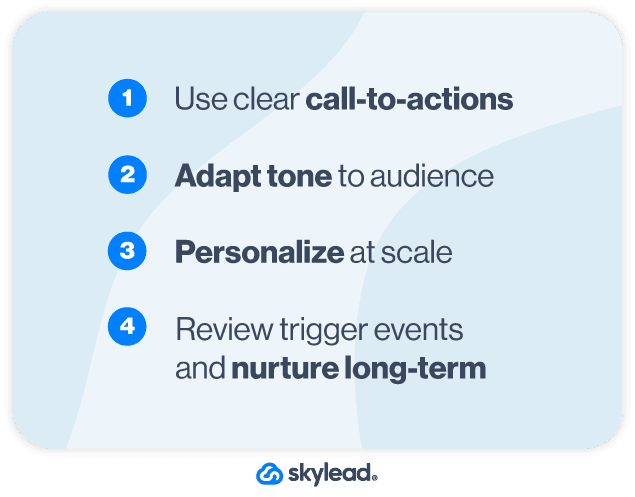
Measuring success: Follow-ups and campaign tracking
Tracking metrics that matter
Strong campaign tracking starts with monitoring the metrics that reveal real performance:
- email opens,
- link clicks, replies
- conversion rate.
These signals show whether your message is resonating and where prospects fall off in the journey. As engagement rises, your engagement data becomes a powerful indicator of interest, so use it to prioritize your next follow-up and support a consistent lead scoring process that identifies who’s most likely to convert.
Using insights to improve future campaigns
Every campaign generates clues about what your audience cares about, so analyze polls, feedback loops, and direct conversations to understand genuine prospect needs. This information strengthens your messaging, improves timing, and guides your next outreach angle.
As your dataset grows, create internal benchmarks for opens, clicks, and replies so you can compare new campaigns against your past performance. Continuous refinement turns outreach into a predictable, evolving system that improves with each send.
FAQ
What is an email outreach strategy?
An email outreach strategy is a structured plan for contacting prospects with personalized, value-focused messages. Its purpose is to start conversations, generate leads, build relationships, and drive sales or partnerships through clear targeting, relevant content, and consistent follow-ups.
How do you write an effective email for outreach?
Write a short, clear email with a personalized opener, a value-driven message, and one simple call-to-action. Use natural language, avoid heavy selling, and make the first sentence relevant to the recipient’s role, pain point, or recent activity.
How do you plan and build an effective email outreach strategy?
Start with clean, verified data, segment your audience, and craft a concise sequence with value-focused messaging. Use A/B testing, automate follow-ups, track opens and clicks, and refine the campaign based on performance and buyer behavior.
What elements or best practices should a good email outreach strategy include?
A strong outreach strategy includes clear targeting, personalized messaging, a single CTA, consistent follow-ups, deliverability optimization, and multichannel touchpoints. It should also use engagement data and trigger events to improve timing, relevance, and response rates.
Ready to build a scalable email outreach strategy?
So, let’s recap. A scalable email outreach strategy starts with the fundamentals: sharp research, clean data, meaningful personalization, the right tools, and a follow-up system that keeps conversations alive. When these elements work together, outreach becomes a predictable driver of lead generation and long-term customer relationships.
Just remember to continue refining your approach through ongoing campaign tracking, A/B testing, and small improvements every time you send a sequence. Outreach isn’t a one-time setup; it’s an evolving system that gets stronger with each iteration.
If you're ready to build a strategy that consistently wins attention, earns replies, and grows with your business, now’s the perfect moment to put these steps into action. Start today by joining Skylead for a free trial. It’s that easy.





